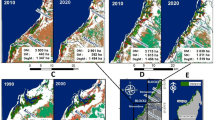Abstract
We examined the impact of various coastal developments on mangrove cover along the Kilim River, Langkawi Island, Malaysia between 1996 and 2008. We analysed images from Systeme Probatoire d’Observation de la Tarre (SPOT) of Kilim River using supervised classification and Principal Component Analysis (PCA). Over 8% (176.83 ha) of mangrove cover was degraded along the Kilim River from its total area of 2153.07 ha during the past 14 years. We identified several causes of mangrove degradation, including mangrove clearing (38%), mangrove conversion to commercial area (21%), residential area (19%), agriculture (12%), aquaculture (12%) and wake current (6%). Langkawi is one of the main tourism islands in Malaysia. Tthe pace of coastal development throughout the entire island including Kilim River had suppressed the mangroves propagation over the years. Long term monitoring of mangrove ecosystems is essentials to ensure the survival and sustainability of mangrove associated biodiversity.
Similar content being viewed by others
References
Alongi DM. 2009. The Energetic of Mangrove Forest (1st Ed.), New York: Springer, pp. 1–125.
Aston EC, Macintosh DJ. 2002. Preliminary assessment of the plant diversity and community ecology of the Sematan mangrove forest, Sarawak, Malaysia. Forest Ecology and Management, 166: 111–129.
Azahar M, Nik MS. 2009. A Working Plan for the Matang Mangrove Forest Reserved, Perak (5th Ed), Perak: State Forestry Department Publication.
Blasco F, Janodet E, Bellan MF. 1994. Impacts of coastal hazards on mangroves in the Bay of Bengal. Journal of Coastal Research, 12:277–88.
Brakel WH. 1984. Seasonal dynamics of the suspended sediment plumes from Tano and Sabaki Rivers, Kenya: analysis of coastal imagery. Remote Sensing of Environment, 18: 165–173.
Congalton RG. 1991. A review of Assessing the Accuracy of Classification of Remotely Sensed Data. Remote Sensing Environment, 37: 35–46.
FAO. 2007. The World’s Mangroves 1980–2005. Rome: FAO, pp. 21–27.
Farnsworth EJ, Ellison AM. 1997. The global conservation status of mangroves. Ambio, 26: 328–334.
Faust NL. 1989. Image enhancement in Encyclopedia of Computer Science and Technology (Vol. 20). New York: Marcel Dekker Inc.
Gang PO, Agatsiva JL. 1992. The current status of mangroves along the Ken yan coast: a case study of Mida Creek mangroves based on remote sensing. Hydrobiologia, 247: 29–36.
Green EP, Clark CD, Mumby PJ, Edwards AJ, Ellis AC. 1998. Remote sensing techniques for mangrove mapping. International Journal of Remote Sensing, 19(5): 935–956.
Imhoff ML, Gesch DB. 1990. The derivation of a sub-canopy digital terrain model of a flooded forest using synthetic aperture radar. Photogrammetric Engineering and Remote Sensing, 56(8): 1155–62.
Imhoff ML, Vermillion C, Story MH. 1987. Monsoon flood boundary delineation and damage assessment using space borne imaging radar and Landsat data. Photogrammetric Engineering and Remote Sensing, 53(4): 405–413.
Jensen JR, Lin H, Yang XH, Ramsey EW. 1991. The measurement of mangrove characteristics of southwest Florida using SPOT multispectral data. Geocarto International, 2:13–21.
Klemas V, Bartlett DS. 1975. Coastal zone classification from satellite imagery. Photogrammetric Engineering and Remote Sensing, 41(4):499–513.
Lillesand TM, Kiefer RW, Chipman JW. 2004. Remote Sensing and Image Interpretation. New York: John Wiley and Sons Inc., p. 763.
Mumby PJ, Edwards AJ, Arias-Gonzalez E, Lindeman KC, Blackwell PG, Gall A, Gorzynska MI, Harborne AR, Pescod CL, Renken H, Wabnitz CCC, Llewellyn G. 2004. Mangroves enhance the biomass of coral reef fish communities in the Carribean. Nature, 427: 533–536.
Naylor RL, Goldburg RJ, Primavera JH, Kautsky N, Beveridge MCM, Clay J, Folke C, Lubchencho J, Mooney H, Troell M. 2000. Effect of aquaculture on world fish supplies. Nature, 405: 1017–1024.
Perez Osuna F. 2000. The environmental impact of shrimp aquaculture: a global perspective. Environmental Pollution, 112: 1–3.
Peter JH. 2007. The Biology of Mangroves and Seagrasses (2nd Ed.). New York: Oxford University Press, pp. 183–202.
Ramsey EW, Jensen JR. 1996. Remote sensing of mangrove wetlands: relating canopy spectra to site-specific data. Photogrammetric Engineering and Remote Sensing, 62(8): 939–48.
Saenger P. 2002. Mangrove Ecology, Silviculture, and Conservation. Dordrecht: Kluwer Academic Publisher, pp. 243–265.
Silapathong CH, Blasco F. 1992. The application of geographic information systems to mangrove forest management: Khlung, Thailand. Asian Pacific Remote Sensing Journal, 5(1): 97–104.
Spalding M, Blasco F, Field C. 1997. World Mangrove Atlas. Okinawa: International Society for Mangrove Ecosystems (ISME), p. 31.
Terchunian A, Klemas V, Asegovia M. 1986. Mangrove mapping in Ecuador: the impact of shrimp pond construction. Environmental Management, 10(3): 345–50.
Tse P, Nip THM, Wong CK. 2008. Nursery function of mangrove: A comparison with mudflats in terms of fish species composition and fish diet. Estuarine, Coastal and Shelf Science, 80: 235–242.
Vaiphasa C, Ongsomwang S, Vaiphasa T, Skidmore AK. 2005. Tropical mangroves species discrimination using hyperspectral data: a laboratory study. Estuarine, Coastal and Shelf Science, 65: 371–379.
Author information
Authors and Affiliations
Corresponding author
Additional information
Foundation project: The study was funded by Mangrove Cluster Research under Institute of Oceanographic and Maritime Studies (INOCEM), International Islamic University Malaysia.
Rights and permissions
About this article
Cite this article
Shahbudin, S., Zuhairi, A. & Kamaruzzaman, B.Y. Impact of coastal development on mangrove cover in Kilim river, Langkawi Island, Malaysia. Journal of Forestry Research 23, 185–190 (2012). https://doi.org/10.1007/s11676-011-0218-0
Received:
Accepted:
Published:
Issue Date:
DOI: https://doi.org/10.1007/s11676-011-0218-0




